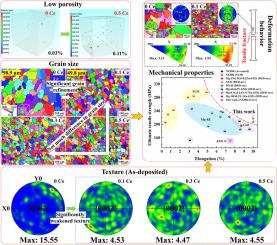Ce微合金化增强定向能沉积Mg-3.0Nd-0.2Zn-0.3Zr合金的强度-塑性协同效应
IF 13.8
1区 材料科学
Q1 METALLURGY & METALLURGICAL ENGINEERING
引用次数: 0
摘要
通过合金化可以控制晶粒尺寸和织构,从而提高镁稀土合金的强度和延展性。定向能沉积电弧是一种典型的亚快速凝固过程,有助于微观组织的改变。本文采用电弧放电法制备了一系列不同Ce含量(0、0.1、0.3、0.5 wt.%)的Mg-3.0Nd-0.2Zn-0.3Zr-xCe (NZ30K-xCe)合金。结果表明,实验合金的孔隙率较低(≤0.11 %)。添加0.1 wt.% Ce后,平均晶粒尺寸由98.9±5.7µm减小到49.8±1.0µm,织构明显减弱。与NZ30K-0.1Ce合金相比,进一步添加Ce(0.3和0.5 wt.%)不会导致平均晶粒尺寸和织构强度的显著变化。晶粒细化与组织过冷有关,织构弱化与Ce在Mg基体中的固溶性有关。NZ30K-0.1 ce合金的极限抗拉强度和伸长率分别比NZ30K合金高37.2% %和61.3 %。晶粒细化和织构弱化是NZ30K-0.1Ce合金具有较好强度-塑性的原因。本文章由计算机程序翻译,如有差异,请以英文原文为准。

Enhanced strength-ductility synergy of directed energy deposited Mg-3.0Nd-0.2Zn-0.3Zr alloy via micro-alloying with Ce
Grain size and texture can be controlled to improve the strength and ductility of magnesium rare-earth (Mg-RE) alloys by alloying. Directed energy deposition-arc (DED-arc) is a typical sub-rapid solidification process that contributes to the modification of the microstructure. In this paper, a series of novel Mg-3.0Nd-0.2Zn-0.3Zr-xCe (NZ30K-xCe) alloys with different Ce contents (0, 0.1, 0.3, 0.5 wt.%) were prepared by DED-arc. The results show that the experimental alloys have lower porosity (≤0.11 %). After adding 0.1 wt.% Ce, the average grain size decreases from 98.9 ± 5.7 µm to 49.8 ± 1.0 µm, and the texture is significantly weakened. Further additions of Ce (0.3 and 0.5 wt.%) do not lead to significant alterations in the average grain size and texture intensity when compared with the NZ30K-0.1Ce alloy. Grain refinement is related to the constitutional supercooling, and the texture weakening is connected to the solid solubility of Ce in the Mg matrix. The ultimate tensile strength and elongation of NZ30K-0.1Ce alloy are 37.2 % and 61.3 % higher than those of NZ30K alloy. Grain refinement and texture weakening are the reasons for the better strength-ductility of NZ30K-0.1Ce alloy.
求助全文
通过发布文献求助,成功后即可免费获取论文全文。
去求助
来源期刊

Journal of Magnesium and Alloys
Engineering-Mechanics of Materials
CiteScore
20.20
自引率
14.80%
发文量
52
审稿时长
59 days
期刊介绍:
The Journal of Magnesium and Alloys serves as a global platform for both theoretical and experimental studies in magnesium science and engineering. It welcomes submissions investigating various scientific and engineering factors impacting the metallurgy, processing, microstructure, properties, and applications of magnesium and alloys. The journal covers all aspects of magnesium and alloy research, including raw materials, alloy casting, extrusion and deformation, corrosion and surface treatment, joining and machining, simulation and modeling, microstructure evolution and mechanical properties, new alloy development, magnesium-based composites, bio-materials and energy materials, applications, and recycling.
 求助内容:
求助内容: 应助结果提醒方式:
应助结果提醒方式:


